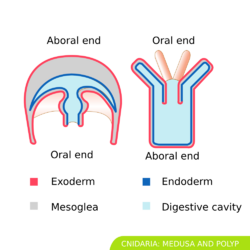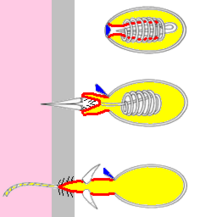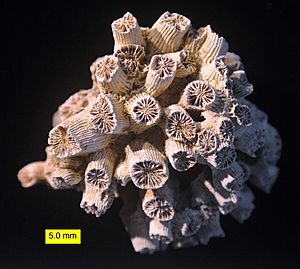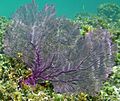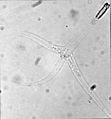Cnidaria facts for kids
Quick facts for kids Cnidaria |
|
|---|---|
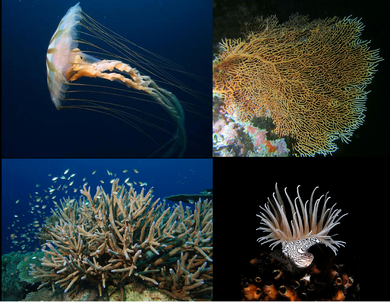 |
|
Four examples of cnidaria (clockwise, from top left):
|
|
| Scientific classification |
|
| Kingdom: | Animalia |
| Subkingdom: | Eumetazoa |
| Clade: | ParaHoxozoa |
| Phylum: | Cnidaria Hatschek, 1888 |
| Subphyla and classes | |
|
|
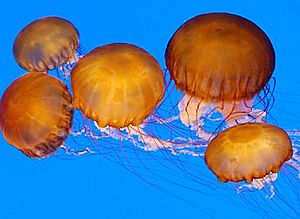
Cnidarians (say "nih-DAIR-ee-uh") are a fascinating group of aquatic animals. They include well-known creatures like jellyfish, sea anemones, and corals. You can find them in both fresh water and oceans, though most live in the sea. There are over 11,000 different kinds of cnidarians. A special feature of cnidarians is their soft, jelly-like bodies and unique stinging cells called cnidocytes. These cells help them catch food and protect themselves.
Contents
- What Makes Cnidarians Special?
- Cnidarian Body Forms
- How Cnidarians Get Support
- Inside a Cnidarian's Body
- Different Forms for Different Jobs
- Amazing Stinging Cells (Cnidocytes)
- How Cnidarians Move
- Nervous System and Senses
- How Cnidarians Eat and Breathe
- Regeneration Power
- Cnidarian Life Cycle and Reproduction
- Types of Cnidarians
- Cnidarians in Their Environment
- Ancient Animals: Evolutionary History
- Cnidarians and Humans
- Images for kids
- See also
What Makes Cnidarians Special?
Cnidarians are more complex than sponges but simpler than most other animals like fish or mammals. They have special features that set them apart.
Unique Stinging Cells
Cnidarians are the only animals with cnidocytes. These cells shoot out tiny, harpoon-like structures. They use these for catching prey and sometimes for defense.
Simple Body Plan
Unlike humans, cnidarians have only one opening in their body. This opening acts as both a mouth for eating and an exit for waste. Their bodies have two main layers of cells. Between these layers is a jelly-like substance called mesoglea. More complex animals have three cell layers.
Basic Nervous System
They have a simple nerve net spread throughout their body. This helps them coordinate their movements and react to their surroundings.
Cnidarian Body Forms
Most cnidarians have two main body shapes. Many species can switch between these two forms during their lives. Both forms have tentacles around their mouth, which are covered in stinging cells.
Medusa Shape
Medusae are free-swimming, bell-shaped forms. A typical jellyfish is a great example of a medusa. They float or swim in the water.
Polyp Shape
Polyps are usually attached to a surface, like a rock or the seabed. They look like a tube with a mouth and tentacles at one end. Sea anemones and corals are good examples of polyps.
How Cnidarians Get Support
Cnidarians get their support in different ways.
Jelly-like Support
For medusae, their thick, springy mesoglea acts as their main support. It helps them keep their shape and allows them to swim.
Water Pressure Support
Many polyps, like hydra and sea anemones, use water inside their bodies as a hydrostatic skeleton. This is like a water balloon that keeps its shape.
Hard Skeletons
Some colonial polyps, especially corals, build hard outer skeletons made of calcium carbonate. These hard skeletons form the basis of coral reefs. Other polyps might use tough fibers or even collect sand to strengthen their bodies.
Inside a Cnidarian's Body
Cnidarians are called diploblastic because they have two main layers of cells.
Outer and Inner Layers
The outer layer faces outwards. It contains cells that help with movement, stinging cells (cnidocytes), and simple nerve cells. The inner layer faces inwards, lining their digestive cavity. It has cells that release enzymes to digest food.
The Mesoglea
Between these two layers is the mesoglea, a non-living, jelly-like substance. It can contain a few special cells that help transport nutrients.
Different Forms for Different Jobs
Some cnidarians show polymorphism. This means different individuals within the same species can have different shapes and jobs. For example, in some colonial cnidarians, some individuals might be specialized for feeding, others for defense, and others for reproduction. They all work together as one organism.
Amazing Stinging Cells (Cnidocytes)
These are the amazing "nettle cells" that give cnidarians their name! They are like tiny, powerful harpoons.
There are a few types:
- Nematocysts: These are the most common. They inject venom into prey and have barbs to hold on.
- Spirocysts: These don't inject venom. Instead, they have sticky hairs that entangle the prey.
- Ptychocysts: These are special. They are not used for catching food. Instead, they help build protective tubes for the cnidarian to live in.
Each cnidocyte has a tiny trigger hair. When something touches it, or when certain chemicals are detected, the cell fires. A coiled thread shoots out very quickly, like a spring. This thread can inject venom or stick to the prey. Once a cnidocyte fires, it cannot be used again. The animal needs about two days to replace it. To avoid wasting these cells, they usually need two signals to fire: a chemical signal and a touch signal.
How Cnidarians Move
Medusa Movement
Jellyfish swim using a kind of jet propulsion. They squeeze water out of their bell-shaped bodies using muscles. The springy mesoglea then helps the bell return to its original shape. This pushes them through the water. They are not very strong swimmers and mostly drift with currents.
Polyp Movement
Some polyps, like hydra and sea anemones, can move slowly. They might creep like snails or even do somersaults across surfaces.
Nervous System and Senses
Cnidarians do not have a brain like humans. Instead, they have a simple nerve net spread throughout their body. This network helps them coordinate their movements and react to their environment. They also have simple sensory organs called rhopalia. These can detect light, changes in pressure, and chemicals in the water. Some jellyfish even have simple eyes that can tell the direction of light. Box jellyfish are special because they have more complex eyes with lenses, allowing them to see objects.
How Cnidarians Eat and Breathe
Feeding and Excretion
Most cnidarians are predators. They use their stinging cells to catch small organisms, from tiny plankton to larger animals. Once prey is caught, tentacles move it towards the mouth. Gland cells inside their digestive cavity release enzymes to break down the food into a liquid. This liquid circulates, and cells absorb the nutrients. Any parts of the prey that cannot be digested are pushed back out through the same opening that serves as a mouth. Waste products from their cells, like ammonia, are simply released into the surrounding water.
Respiration
Cnidarians do not have lungs or gills. They breathe by absorbing oxygen directly from the water through their body surface. At the same time, they release carbon dioxide into the water. Water currents, either external or internal (in their digestive cavity), help with this exchange. Some cnidarians have tiny algae living inside their cells. These algae produce oxygen through photosynthesis.
Regeneration Power
Cnidarians are amazing at regenerating! This means they can regrow lost or damaged body parts. If a cnidarian is injured, it can often recover completely. This ability also allows them to reproduce asexually, creating new individuals from pieces of themselves.
Cnidarian Life Cycle and Reproduction
Cnidarians have interesting ways of making new individuals.
Sexual Reproduction
Many cnidarians have a complex life cycle that involves both polyp and medusa stages. For example, in jellyfish and box jellyfish:
- A tiny larva swims until it finds a good spot to settle.
- It then grows into a polyp, which stays attached to a surface.
- This polyp then starts to split horizontally, forming many small, young jellyfish. This process is called strobilation.
- These young jellyfish swim away and grow into adult medusae.
- Adult medusae release eggs and sperm into the water, which combine to form new larvae, starting the cycle again.
Some cnidarians, like sea anemones and corals, only have a polyp stage and reproduce sexually as polyps. Others, like some oceanic jellyfish, skip the polyp stage entirely. Sometimes, many cnidarians in one area release their eggs and sperm at the same time. This creates a cloudy "spawning" event, like on the Great Barrier Reef. This ensures that many eggs get fertilized.
Asexual Reproduction
All cnidarians can also reproduce without needing eggs and sperm. This is called asexual reproduction.
- Budding: A new individual simply grows out of the side of the parent, like a small bud, and then breaks off.
- Splitting: Some polyps can split themselves in half, creating two new individuals.
Asexual reproduction creates clones, which are exact copies of the parent. This helps them quickly increase their numbers.
Types of Cnidarians
Scientists group cnidarians into several main classes:
- Anthozoa: This group includes sea anemones and corals. They are mostly sessile, meaning they stay attached to one spot. They only exist as polyps.
- Scyphozoa: These are the "true" jellyfish. They spend most of their lives as free-swimming medusae.
- Cubozoa: These are the box jellyfish. They are known for their cube-shaped bells and can be very dangerous.
- Hydrozoa: This is a very diverse group. It includes freshwater cnidarians like hydra, as well as many marine forms like the Portuguese man o' war. They can have both polyp and medusa stages.
- Staurozoa: These are unique "stalked jellyfish" that are attached to surfaces.
- Myxozoa and Polypodiozoa: These are tiny, often parasitic cnidarians. Scientists only recently confirmed they belong to this group.
Cnidarians in Their Environment
Cnidarians live in many different environments. While many corals need warm, shallow waters with sunlight for their symbiotic algae, other cnidarians can be found in deep, cold oceans, polar regions, and even fresh water.
What They Eat
Most cnidarians hunt for food, from tiny plankton to larger animals. Some get nutrients from tiny algae living inside them. A few are even parasites, living on or in other organisms.
Who Eats Them
Many animals prey on cnidarians. These include starfish, sea slugs, fish, and sea turtles. Some sea slugs can even steal the stinging cells from cnidarians and use them for their own defense!
Coral Reefs
Coral reefs are built by stony corals (Anthozoa). These reefs are incredibly important ecosystems. They provide homes and food for countless other marine creatures. They also protect coastlines from strong waves.
Ancient Animals: Evolutionary History
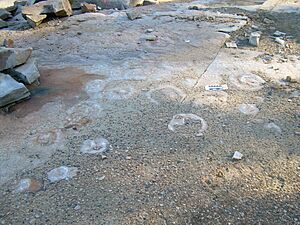
Cnidarians are a very ancient group of animals. Some of the earliest animal fossils ever found, dating back about 580 million years, are thought to be cnidarians. This means they existed long before the "Cambrian Explosion," a time when many new animal forms appeared. Fossils show that corals have been around for hundreds of millions of years, building reefs that have changed over geological time.
Cnidarians and Humans
Cnidarians have a big impact on humans.
Food and Tourism
Some large jellyfish species are eaten as a delicacy in parts of Asia. Coral reefs are huge attractions for tourists, divers, and photographers. They bring a lot of income to tropical islands.
Protection and Resources
Reefs protect coastal areas from strong currents and waves. Coral has also been used in jewellery for a long time.
Dangers and Challenges
Some cnidarians, especially certain box jellyfish, can deliver very painful and sometimes dangerous stings. It's important to be careful and aware when swimming in areas where they live. Coral reefs face threats from over-fishing, pollution, and damage from human activities like boating and walking on the reefs. It's important to protect these amazing ecosystems.
Images for kids
-
Coral Acropora muricata (Scleractinia)
-
Sea fan Gorgonia ventalina (Octocorallia)
-
Box jellyfish Carybdea branchi (Cubozoa)
-
Siphonophore Physalia physalis (Hydrozoa)
-
Jellyfish Phyllorhiza punctata (Scyphozoa)
-
Stalked jelly Haliclystus antarcticus (Staurozoa)
See also
 In Spanish: Cnidaria para niños
In Spanish: Cnidaria para niños


